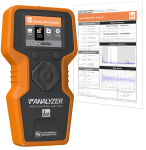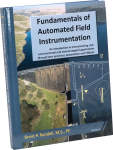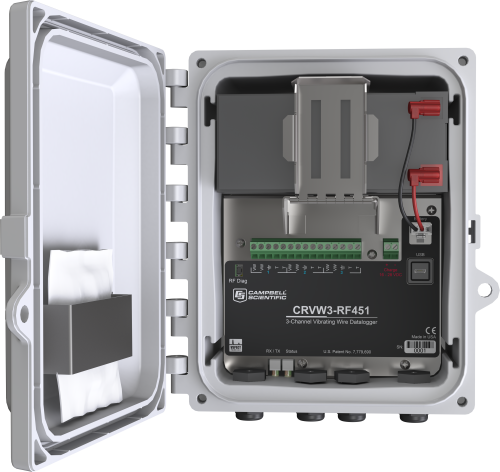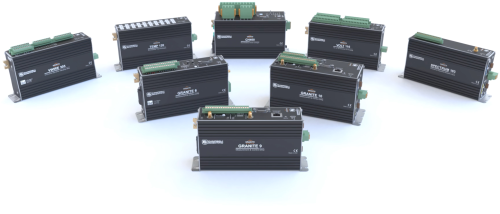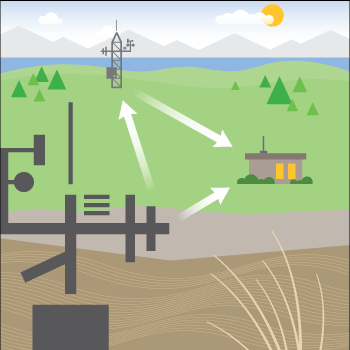Cómo podemos ayudarle
The versatility, ruggedness, and reliability of Campbell Scientific measurement automation platforms make them ideal for a variety of applications, including geotechnical, water level, water quality, slope stability analysis, weather monitoring, ambient air quality, environmental compliance, dam and tailing monitoring, mine ventilation, equipment performance, image capture, and roof and shaft stability.
- Reduce the uncertainty. Using automated measurements for data integrity, security, quality control, and local alarming capabilities, our systems are built to reduce your project uncertainty.
- Make your operations more efficient. Our systems are designed to make your measurement automation setup and long-term operation simple and fast.
- Get high performance, no matter the size, with scalability. We offer platforms to accommodate your small, single projects to large-scale, multi-site operations.
- Benefit from the flexibility of an open ecosystem. You can own your data, own your network, and control your configuration with capabilities to plug and play, self-configure, and interface with any commercially available sensor.
- Share your data. Powerful reporting, dashboard building, and built-in data sharing tools keep everyone informed, including your stakeholders.
Measurement automation platforms are unique to each application because of the many types of measurements they are required to collect.
In addition to real-time data measurement, each measurement device will alert you of parameter changes if they move beyond acceptable ranges. Historical and real-time data can be transmitted directly to the cloud or to your PC. Measurement automation platforms are rugged, low power, and adaptable to the harshest, most remote environments.
We understand that it’s an absolute necessity for you to have a platform design that can operate not only in harsh, remote locations—where unsafe conditions are often not suitable for personnel—but also to have a system that is reliable enough to maintain human safety. Because of this, Campbell Scientific automated monitoring systems provide you with many benefits:
- Reduced worker hours, fuel expenses, and safety risks by eliminating the manual data collection from sensors
- Increased data availability (data available 24/7)
- Improved data integrity
- Better worker and public safety
- Ability to monitor critical parameters even during shutdown or long-term care and maintenance
- Cost-effective implementation of governance for environmental and safety solutions
Allow our team of experienced application engineers to make this easy as they help you build a monitoring system specific to the measurements you need.
Learn about our patented VSPECT® spectral-analysis technology at our VSPECT Essentials web resource.
Learn about dynamic vibrating wire sensor measurements at our Dynamic Vibrating Wire web resource.
The dynamic vibrating wire measurement technique is protected under U.S. Patent No. 8,671,758, and the vibrating wire spectral-analysis technology (VSPECT) is protected under U.S. Patent No. 7,779,690.
Saber másConsulte algunos excelentes ejemplos de lo que nuestros equipos pueden hacer en este área
Sistema a medida
Además de nuestros sistemas estándar, muchos de los sistemas que comercializamos son personalizables y adaptables a sus necesidades. Díganos que necesita y le ayudamos a configurar el sistema de medida que se ajuste a sus necesidades.
Categorías de Producto relacionadas
Más detalles acerca de nuestro Minería Sistemas
Mining Measurement Automation Platforms
From an asset management perspective, automated instrumentation enables much more responsive decision-making, allowing for quasi-real-time monitoring. In mining processes, there are many examples of applications of this approach:
Tailings Production—With increasingly stringent legal constraints, mining companies have automated their tailings spigot disposal systems to produce according to the water input reaching the tailings disposal structure reservoirs, ensuring the safe operation of their structures.
Activation of Spillway Structures—Tailings dams have automatic activation systems for spillway structures based on reservoir levels, an excellent measure to eliminate the risk of overtopping.
Automated Instrumentation—Whether crackmeters in underground caverns, inclinometers on open-pit mine slopes, or piezometers installed in tailings piles, automated instruments are becoming more common to obtain quasi-real-time data, thus prioritizing actions pertinent to asset safety management.
Environmental Monitoring—Due to environmental constraints, many weather stations are often installed in remote locations with difficult access. Automated monitoring allows more frequent data collection without site visits.
Slope Stability—Slope movement can be monitored 24/7 for long periods in harsh conditions with instantaneous communication alarms when critical thresholds have been met.
Our platforms' versatility allows them to be customized for each application. We offer a range of platforms, from the most basic device with just a few channels to expandable platforms that measure hundreds of channels. Scan rates can be programmed from once every few hours to 10,000 times per second, depending on the model. Measurement types, processing algorithms, and recording intervals are also programmable.
The measurement automation platform has a simple, yet powerful on-board instruction set. Simply choose the sensor type, scan rate, and measurement channel. On-board mathematical and statistical processing allows data reduction in the field and enables measurements to be viewed in the desired units, whether that is microstrains, centimeters per second, revolutions per minute, meters, Amperes, or inches.
The measurement automation platforms' versatility extends to control as well. Each platform can monitor and control external devices based on time or measured conditions, enabling the design of Emergency Action Plans and Trigger Action Response Plans (TARPs) to warn of—or possibly prevent—dangerous conditions allow time and equipment savings. Campbell Scientific platforms are rugged enough to be used in mining sites worldwide.
The measurement automation platform can stand alone. After it is programmed and powered, no human or computer interaction is required, although data are typically downloaded to a PC or exported to the cloud for further analysis. A telecommunications or hardwire link allows data to be monitored and graphed in your office rather than in the field. Data from various stations and applications can be monitored from a single laptop or desktop computer.
The low power drain typically allows our platforms to be powered by solar panels and batteries. If 110/220-Vac power or external 12-Vdc batteries are available, you can use those as well. Nonvolatile data storage and a battery-backed clock ensure data capture and integrity.
Training
Campbell Scientific offers training courses that can be conducted at your location and customized to meet your specific needs. Hands-on training with our engineers helps ensure your system provides the site condition data you need today and into the future.
Sensors Used for Mining Measurements
Our measurement automation platforms' flexibility begins with sensor compatibility. Our platforms can measure virtually every commercially available sensor, allowing them to be used in different ways for a variety of measurements. For example, the following are common parameters that the sensors in our platforms measure:
- Pore water pressure
- Water level
- Water flow
- Settlement
- Displacement
- Strain
- Stress
- Tilt
- Inclination
- Weight
- Force
- Pressure
- Deflection
- Barometric pressure
- Temperature
- Humidity
- Elevation
More specifically, these are the sensor types commonly used in our measurement automation platforms:
- Foil-bonded strain gauges
- Vibrating wire strain gauges
- Strainmeters
- Extensometers
- Jointmeters
- Crackmeters
- Deformation meters
- Piezometers
- Pressure transducers
- Barometers
- Settlement sensors
- Borehole pressure cells
- Earth pressure cells
- Load cells
- Pressure cells
- Inclinometers
- Tiltmeters
- Tilt beams
- Stressmeters
- Thermistors
- Thermocouples
- Deformation sensors
- Accelerometers
- Sonic water-level sensors
- Displacement transducers
- Linear variable differential transformers (LVDT)
Because our measurement automation platforms have many channel types and programmable inputs, all these sensor types can be measured by one device. Channel types include analog (single-ended and differential), pulse counter, switched excitation, continuous analog output, digital I/O, and anti-aliasing filter. Using switched or continuous excitation channels, our platforms provide excitation for ratiometric bridge measurements.
The following are common sensor measurement types that our measurement automation platforms are compatible with:
- Frequency
- Resistance
- Voltage
- Ratiometric
- Current
- Modbus RTU
- RS-485
- SDI-12
Communications
Multiple communications options are available for retrieving, storing, and displaying data, allowing platforms to be customized to meet your exact needs. Onsite communications options include direct connection to a PC or laptop, PC cards, storage modules, and platform keyboard/display. Telecommunications options include short-haul, telephone (including voice-synthesized and cellular), radio frequency, multidrop, and satellite.
Documentos
Casos de aplicación
The Homestake Neutrino Experiment—also referred to as the “Davis Experiment” after physicist Ray Davis, who......leer más
Background Tailings dams are crucial components of mining operations, responsible for storing water used in the......leer más
Preguntas frecuentes
Número de FAQs relacionadas con Minería: 6
Expandir todoDesplegar todo
-
With a mining automated monitoring system, how is the data transmitted from the field to the office?
Campbell Scientific monitoring systems can communicate with a PC using several different methods, including cell modems, Wi-Fi, satellite, and radio. One common method is to use Campbell Scientific’s spread-spectrum radios to transmit the data over tens of kilometers back to a server. The monitoring stations can act as repeaters to repeat the data stream to easily overcome long distances or line-of-sight obstructions.
-
Almost any sensor type can be measured by a Campbell Scientific monitoring system due to our open architecture and flexible design: voltage output, vibrating-wire, resistive, digital, and more.
-
Yes. Satellite modems are often used to provide communications when other services are available.
-
No. A typical geotechnical monitoring system that reads up to 16 geotechnical sensors can be powered year-round by a battery about the size of a motorcycle battery along with a 20-watt solar panel.
-
Yes. Campbell Scientific monitoring systems have a wide operating range, as low as -55°C and up to +85°C.
-
Yes. The monitoring system needs to be connected to the sensor wires, but small-scale/low-cost monitoring systems make it cost effective to put systems on single sensors.
Integradores y Distribuidores
Artículos y notas de prensa
Privacy Policy Update
We've updated our privacy policy. Learn More
Cookie Consent
Update your cookie preferences. Update Cookie Preferences





